A Methodology to Determine the Effective Plastic Zone Size Around Blunt V-Notches under Mixed Mode I/II Loading and Plane-Stress Conditions
Abstract
:1. Introduction
2. Elastic Stress Field and Plastic Zone Size at the Tip of Blunt V-Notches
2.1. Linear Elastic Stress Field for Round-Tip V-Notches under Mixed Mode I/II Loading
2.2. Formulation of the Plastic Zone in the Vicinity of Round-Tip V-Shaped Notches
2.2.1. Formulation Based on the von Mises Yield Criterion and under Plane-Stress Conditions
2.2.2. Formulation Based on the Tresca Yield Criterion and under Plane-Stress Conditions
2.3. Second Estimation of the Plastic Zone Size (PZS)
3. Verification of the Proposed Formulations
3.1. Verification in the Particular Case of Sharp Cracks
3.2. Verification of the Analytical Estimations by Finite Element Analysis
4. Results and Discussion
5. Conclusions
- The stress solution around round-tip V-notches under mixed mode I/II loading is an approximation to the actual stress state. This research revealed that it can successfully be used to formulate the plastic zone size (PZS) in the neighborhood of blunt V-shaped notches under plane-stress conditions and based on the von Mises and Tresca yield criteria.
- The accuracy of the stress solutions out of the direction normal to the maximum tangential stress (MTS) depends on many factors; namely and most importantly, the stress field only satisfies the boundary conditions on the limited area on the round edge of the notch. This makes the shape of the plastic zones acquired from the analytical solution different from that obtained from the FE analyses. However, the effective plastic zone size (EPZS), which is important for the determination of the ductile failure regime in notched components, can be accurately and conveniently obtained by using the proposed analytical formulas.
- This research showed that when the notch rotation angle (β) was equal to 25°, the accuracy of the suggested analytical solutions for calculating the EPZS was better when the von Mises yield criterion is used. However, when β was equal to 50°, the Tresca yield criterion provided finer results.
- The proposed methodology was derived from Irwin’s approach, which neglects the strain-hardening of the material being analyzed and assumes elastic perfectly plastic behavior. When the plasticity of the material is high, in terms of strain hardening and strain-to-failure, the difference between the average flow stress (σ0) and the yield stress (σY) increases, and the methodology provides worse estimations of the PZS. To avoid this, it is suggested to use σY when the material being analyzed develops significant hardening and strain-to-failure. Otherwise, the average flow stress should be used.
Author Contributions
Funding
Data Availability Statement
Conflicts of Interest
Appendix A
| 2α (deg.) | |||||
|---|---|---|---|---|---|
| 0 | 0.5000 | −0.5000 | 1.0000 | 4.0000 | 0.0000 |
| 0.5014 | −0.4560 | 1.0707 | 3.7907 | 0.0632 | |
| 0.5050 | −0.4319 | 1.1656 | 3.572 | 0.0828 | |
| 0.5122 | −0.4057 | 1.3123 | 3.2832 | 0.0960 | |
| 0.5448 | −0.3449 | 1.8414 | 2.5057 | 0.1046 | |
| 0.6157 | −0.2678 | 3.0027 | 1.5150 | 0.0871 | |
| 0.6736 | −0.2198 | 4.1530 | 0.9933 | 0.0673 | |
| 0.7520 | −0.1624 | 6.3617 | 0.5137 | 0.0413 |
| 2α (deg.) | |||||
|---|---|---|---|---|---|
| 0 | 0.5000 | −0.5000 | 1.0000 | −12.0000 | 0.0000 |
| 0.5982 | −0.4465 | 0.9212 | 11.3503 | −0.3506 | |
| 0.6597 | −0.4118 | 0.8140 | 10.1876 | −0.4510 | |
| 0.7309 | −0.3731 | 0.6584 | −8.3946 | −0.4788 | |
| 0.9085 | −0.2882 | 0.2189 | −2.9382 | −0.2436 | |
| 1.1489 | −0.1980 | −0.3139 | 4.5604 | 0.5133 | |
| 1.3021 | −0.1514 | −0.5695 | 8.7371 | 1.1362 | |
| 1.4858 | −0.1034 | −0.7869 | 12.9161 | 1.9376 |
References
- Larsson, S.G.; Carlsson, A.J. Influence of non-singular stress terms and specimen geometry on small-scale yielding at crack tips in elastic-plastic materials. J. Mech. Phys. Solids 1973, 21, 263–277. [Google Scholar] [CrossRef]
- Rice, J.R. Limitations to the small scale yielding approximation for crack tip plasticity. J. Mech. Phys. Solids 1974, 22, 17–26. [Google Scholar] [CrossRef]
- Yeh, H.Y.; Ahmed, K.; Yeh, H.L. Change of damage zone size by T-stress. J. Reinf. Plast. Comp. 2005, 25, 645–661. [Google Scholar] [CrossRef]
- Sousa, R.A.; Castro, J.T.P.; Lopes, A.A.O.; Martha, L.F. On improved crack tip plastic zone estimates based on T-stress and on complete stress fields. Fatigue. Fract. Eng. Mater. Struct. 2012, 36, 25–38. [Google Scholar] [CrossRef]
- Folias, E.S. Estimating plastic zone sizes. Int. J. Fract. 1974, 10, 109–111. [Google Scholar] [CrossRef]
- Terada, H. On plastic zone size and COD of SC specimen by Dugdale’s method. Int. J. Fract. 1982, 20, R15–R20. [Google Scholar] [CrossRef]
- Adetifa, O.A. Estimating plastic zone sizes for edge cracks. Int. J. Fract. 1984, 24, 115–120. [Google Scholar] [CrossRef]
- Danyluk, H.T.; Singh, B.M.; Vrbik, J. A dugdale-type estimation of the plastic zone for a penny-shaped crack in a thick transversely isotropic layer due to radial shear. Eng. Fract. Mech. 1995, 51, 735–740. [Google Scholar] [CrossRef]
- Petroski, H.J. Dugdale plastic zone sizes for edge cracks. Int. J. Fract. 1979, 15, 217–230. [Google Scholar]
- Lee, B.H.; Chung, S.K. Determination of the plastic zone size by cancelling the singularity with proper crack-dislocation-density functions. Int. J. Fract. 1981, 17, 57–60. [Google Scholar] [CrossRef]
- Hoh, H.J.; Xiao, Z.M.; Luo, J. On the plastic zone size and crack tip opening displacement of a Dugdale crack interacting with a circular inclusion. Acta Mech. 2009, 210, 305–314. [Google Scholar] [CrossRef]
- Li, X.Y.; Gu, S.T.; He, Q.C.; Chen, W.Q. Penny-shaped Dugdale crack in a transversely isotropic medium and under axisymmetric loading. Math. Mech. Solids 2012, 18, 246–263. [Google Scholar] [CrossRef]
- Matvienko, Y.G. The Effect of the Non-singular T-stress Components on Crack Tip Plastic Zone under Mode I Loading. Procedia Mater. Sci. 2014, 3, 141–146. [Google Scholar] [CrossRef] [Green Version]
- Huang, X.; Liu, Y.; Dai, Y. Characteristics and effects of T-stresses in central-cracked unstiffened and stiffened plates under mode I loading. Eng. Fract. Mech. 2018, 188, 393–415. [Google Scholar] [CrossRef]
- Kiselev, V.A.; Rivkin, E.Y. Dependence of amount of crack opening and size of plastic zone on the type of stress state. Strength Mater. 1978, 10, 208–211. [Google Scholar] [CrossRef]
- Chang, S.J.; Ohr, S.M. Effect of thickness on plastic zone size in BCS theory of fracture. Int. J. Fract. 1983, 21, 3–13. [Google Scholar] [CrossRef]
- Rogowski, G. Plastic zones for 3D planar cracks embedded in an elastic-plastic layer sandwiched between two elastic adherents. Theor. Appl. Fract. Mech. 2018, 98, 199–209. [Google Scholar] [CrossRef]
- Zhang, B.; Xu, W.; Wu, X.; Yu, Y.; Dong, D. Stress intensity factors and plastic zones of stiffened panels with multiple collinear cracks. Theor. Appl. Fract. Mech. 2020, 110, 102816. [Google Scholar] [CrossRef]
- Benrahou, K.H.; Benguediab, M.; Belhouari, M.; Nait-Abdelaziz, M.; Imad, A. Estimation of the plastic zone by finite element method under mixed mode (I and II) loading. Comp. Mater. Sci. 2007, 38, 595–601. [Google Scholar] [CrossRef]
- Shi, P.P. On the plastic zone size of solids containing doubly periodic rectangular-shaped arrays of cracks under longitudinal shear. Mech. Res. Commun. 2015, 67, 39–46. [Google Scholar] [CrossRef]
- Dotsenko, A.M. Developing Irwin formula to improve the accuracy of evaluation of stresses and crack tip plastic zone size. Mater. Sci. 1993, 29, 42–46. [Google Scholar] [CrossRef]
- Jia, Y.J.; Shi, M.X.; Zhao, Y.; Liu, B. A better estimation of plastic zone size at the crack tip beyond Irwin’s model. J. Appl. Mech. 2013, 80, 051014. [Google Scholar] [CrossRef]
- Fan, M.; Yi, D.; Xiao, Z. Generalized Irwin plastic zone correction for a Griffith crack near a coated-circular inclusion. Int. J. Damage Mech. 2014, 24, 663–682. [Google Scholar] [CrossRef]
- Teimoori, H.; Faal, R.T. Irwin’s plastic zone size assessment for interacting cracks in a circular plane subjected to anti-plane deformation. Procedia Struct. Integr. 2016, 2, 2432–2438. [Google Scholar] [CrossRef] [Green Version]
- Caputo, F.; Lamanna, G.; Soprano, A. An Analytical Formulation for the Plastic Deformation at the Tip of Short Cracks. Procedia Eng. 2011, 10, 2988–2993. [Google Scholar] [CrossRef]
- Oudad, W.; Bachir Bouiadjra, B.; Belhouari, M.; Touzain, S.; Feaugas, X. Analysis of the plastic zone size ahead of repaired cracks with bonded composite patch of metallic aircraft structures. Comp. Mater. Sci. 2009, 46, 950–954. [Google Scholar] [CrossRef]
- Kudari, S.K.; Kodancha, K.G. 3D finite element analysis on crack-tip plastic zone. Int. J. Eng. Sci. Tech. 2010, 2, 47–58. [Google Scholar] [CrossRef] [Green Version]
- Horn, A.J.; Sherry, A.H.; Budden, P.J. Size and geometry effects in notched compact tension specimens. Int. J. Pres. Ves. Pip. 2017, 154, 29–40. [Google Scholar] [CrossRef] [Green Version]
- Yokobori, T.; Kamei, A. The size of plastic zone at the tip of a crack in plane strain state by the finite element method. Int. J. Fract. 1973, 9, 98–100. [Google Scholar]
- Panda, A.K.; Misra, S.; Misra, S.C. Application of finite element method for determination of stress intensity factor and plastic zone geometry in an aluminum alloy sheet under uniaxial tension. Bull. Mater. Sci. 1989, 12, 207–216. [Google Scholar] [CrossRef]
- Kudari, S.K.; Maiti, B.; Ray, K.K. The effect of specimen geometry on plastic zone size: A study using the J integral. J. Strain Anal. Eng. Des. 2007, 42, 125–136. [Google Scholar] [CrossRef]
- Bachir Bouiadjra, B.; Elmeguenni, M.; Benguediab, M.; Belhouari, M.; Nait-Abdelaziz, M. Numerical estimation of the effects of microcavities on the plastic zone size ahead of the crack tip in aluminum alloy 2024 T3. Mater. Des. 2009, 30, 752–757. [Google Scholar] [CrossRef]
- Yi, H.; Jingjie, C.; Gang, L. A new method of plastic zone size determined based on maximum crack opening displacement. Eng. Fract. Mech. 2010, 77, 2912–2918. [Google Scholar] [CrossRef]
- Marques, L.F.N.; Meggiolaro, M.A.; de Castro, J.T.P.; Martha, L.F. Elastoplastic 3D analyses of plastic zone size dependencies on load-to-yield strength and on crack size-to-width ratios under mixed mode I/II. Theor. Appl. Fract. Mech. 2020, 107, 102490. [Google Scholar] [CrossRef]
- Bastun, V.N. Influence of deformation anisotropy on the size of the plastic zone at the tip of an opening mode crack. Strength Mater. 1990, 22, 91–95. [Google Scholar] [CrossRef]
- Romeo, A.; Ballarini, R. The influence of elastic mismatch on the size of the plastic zone of a crack terminating at a brittle-ductile interface. Int. J. Fract. 1994, 65, 183–196. [Google Scholar]
- Kaminsky, A.A.; Kurchakov, E.E.; Gavrilov, G.V. Influence of tension along a crack on the plastic zone in an anisotropic body. Int. Appl. Mech. 2010, 46, 634–648. [Google Scholar] [CrossRef]
- Tay, T.E.; Yap, C.M.; Tay, C.J. Crack tip and notch tip plastic zone size measurement by the laser speckle technique. Eng. Fract. Mech. 1995, 52, 879–893. [Google Scholar] [CrossRef]
- Uguz, A.; Martin, J.W. Plastic zone size measurement techniques for metallic materials. Mater. Charact. 1996, 37, 105–118. [Google Scholar] [CrossRef]
- Tanaka, A.; Yamauchi, T. Size estimation of plastic deformation zone at the crack tip of paper under fracture toughness testing. J. Pack. Sci. Technol. 1997, 6, 268–276. [Google Scholar]
- Walker, C.A.; MacKenzie, P.M. Crack-tip plastic zones assessed by the von Mises yield criterion from strain field data. Int. J. Pres. Ves. Pip. 1994, 57, 359–363. [Google Scholar] [CrossRef]
- Wu, S.C.; Li, C.H.; Luo, Y.; Zhang, H.O.; Kang, G.Z. A uniaxial tensile behavior based fatigue crack growth model. Int. J. Fatigue 2020, 131, 105324. [Google Scholar] [CrossRef]
- Hu, Y.; Wu, S.; Withers, P.J.; Cao, H.; Chen, P.; Zhang, Y.; Shen, Z.; Vojtek, T.; Hutař, P. Corrosion fatigue lifetime assessment of high-speed railway axle EA4T steel with artificial scratch. Eng. Fract. Mech. 2021, 245, 107588. [Google Scholar] [CrossRef]
- Besel, M.; Breitbarth, E. Advanced analysis of crack tip plastic zone under cyclic loading. Int. J. Fatigue 2016, 93, 92–108. [Google Scholar] [CrossRef]
- Dugdale, D.S. Yielding of steel sheets containing slits. J. Mech. Phys. Solids 1960, 8, 100–104. [Google Scholar] [CrossRef]
- Pratap, C.R.; Pandey, R.K. Effect of geometry and finite root radius on plastic zone and tip opening displacement. Eng. Fract. Mech. 1984, 19, 849–861. [Google Scholar] [CrossRef]
- Youshi, H.; Miller, K.J.; Brown, M.W. Complex stress functions and plastic zone sizes for notch cracks subjected to various loading conditions. Fatigue Fract. Eng. Mater. Struct. 1991, 14, 237–258. [Google Scholar] [CrossRef] [Green Version]
- Chatterjee, S.N. Analysis of test specimens for interlaminar mode II fracture toughness, Part 1. Elastic laminates. J. Comp. Mater. 1991, 25, 470–493. [Google Scholar] [CrossRef]
- Chatterjee, S.N. Analysis of test specimens for interlaminar mode II fracture toughness, Part 2. Effects of adhesive layers and material nonlinearities. J. Comp. Mater. 1991, 25, 494–511. [Google Scholar] [CrossRef]
- Shi, S.Q.; Puls, M.P. A simple method of estimating the maximum normal stress and plastic zone size at a shallow notch. Int. J. Pres. Ves. Pip. 1995, 64, 67–71. [Google Scholar] [CrossRef]
- Yeh, H.Y.; Rashid, H.N.; Yeh, H.L. Effect of T-stress on damage zone size predictions of notched laminated composites. J. Reinf. Plast. Comp. 2005, 25, 89–98. [Google Scholar] [CrossRef]
- Torabi, A.R. Tensile failure in blunt V-notched ductile members: A new formulation of the Equivalent Material Concept. Eng. Fract. Mech. 2017, 184, 1–13. [Google Scholar] [CrossRef]
- Torabi, A.R.; Habibi, R. Investigation of ductile rupture in U-notched Al 6061-T6 plates under mixed mode loading. Fatigue Fract. Eng. Mater. Struct. 2015, 39, 551–565. [Google Scholar] [CrossRef]
- Torabi, A.R.; Mohammad Hosseini, B. Large plasticity induced crack initiation from U-notches in thin aluminum sheets under mixed mode loading. Eng. Solid Mech. 2017, 5, 39–60. [Google Scholar] [CrossRef]
- Torabi, A.R.; Alaei, M. Mixed-mode ductile failure analysis of V-notched Al 7075-T6 thin sheets. Eng. Fract. Mech. 2015, 150, 70–95. [Google Scholar] [CrossRef]
- Torabi, A.R.; Berto, F.; Campagnolo, A. Elastic-plastic fracture analysis of notched Al 7075-T6 plates by means of the local energy combined with the equivalent material concept. Phys. Mesomech. 2016, 19, 204–214. [Google Scholar] [CrossRef]
- Gomez, F.J.; Torabi, A.R. Application of the equivalent material concept to the study of the ductile failure due to U-notches. Int. J. Pres. Ves. Pip. 2019, 172, 65–69. [Google Scholar] [CrossRef]
- Torabi, A.R.; Shahbazian, B. Notch tip plastic zone determination by extending Irwin’s model. Theor. Appl. Fract. Mech. 2020, 108, 102643. [Google Scholar] [CrossRef]
- Torabi, A.R.; Shahbazian, B. Semi-analytical estimation of the effective plastic zone size at U-notch neighborhood in thin sheets under mixed mode I/II loading. Eng. Fract. Mech. 2020, 239, 107323. [Google Scholar] [CrossRef]
- Filippi, S.; Lazzarin, P.; Tovo, R. Developments of some explicit formulas useful to describe elastic stress fields ahead of notches in plates. Int. J. Solids Struct. 2002, 39, 4543–4565. [Google Scholar] [CrossRef]
- Lazzarin, P.; Filippi, S. A generalized stress intensity factor to be applied to rounded V-shaped notches. Int. J. Solids Struct. 2006, 43, 2461–2478. [Google Scholar] [CrossRef] [Green Version]
- Anderson, T.L. Fracture Mechanics: Fundamentals and Applications; Taylor & Francis/CRC Press: Boca Raton, FL, USA, 2005. [Google Scholar]
- Ivey, J. Analytic Solutions for the Crack-Tip Plastic Zone under Mixed Mode Loading Conditions. Master’s Thesis, The University of New Mexico, Albuquerque, NM, USA, 2017. [Google Scholar]
- Torabi, A.R.; Kamyab, M. The fictitious material concept. Eng. Fract. Mech. 2019, 209, 7–31. [Google Scholar] [CrossRef]
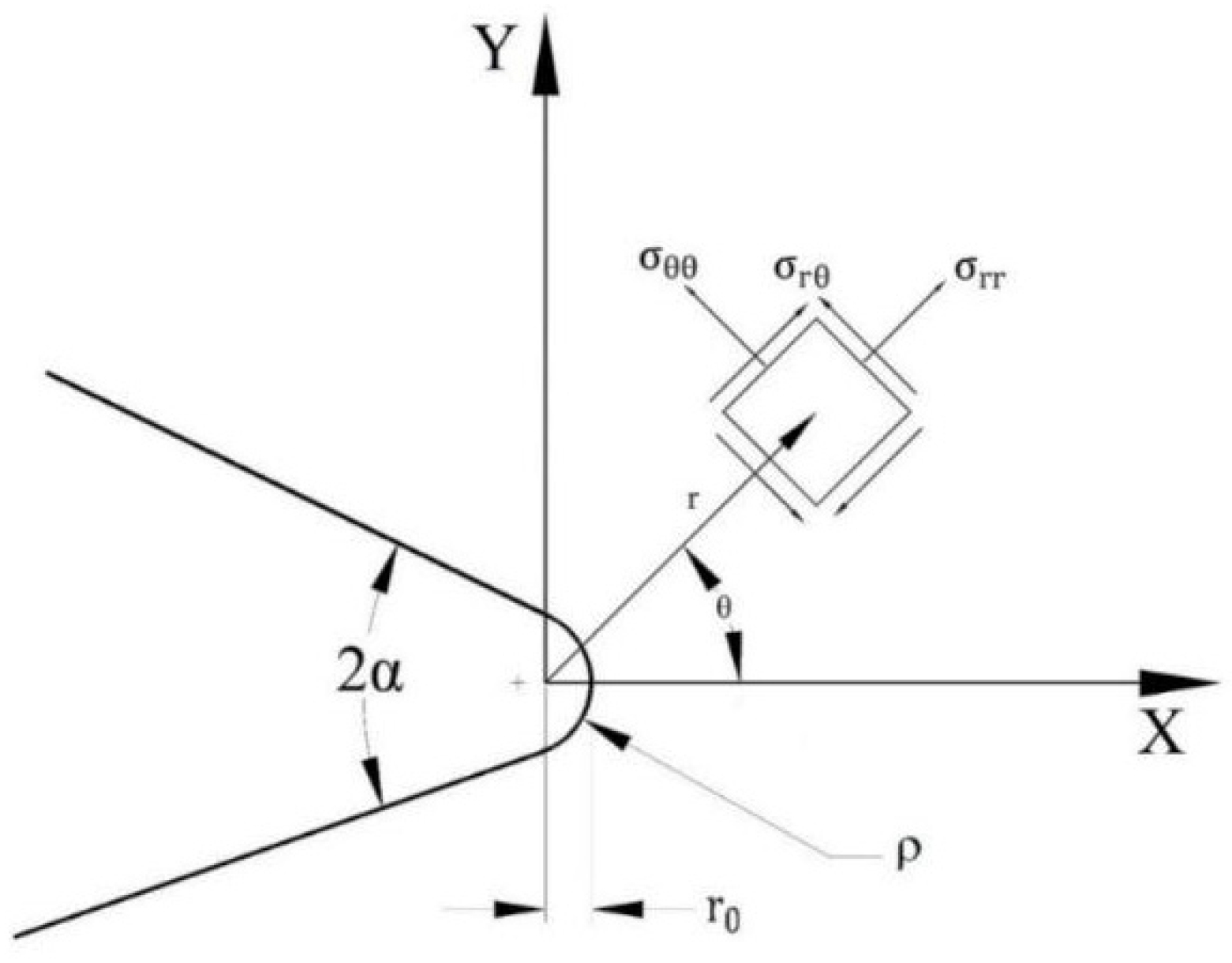


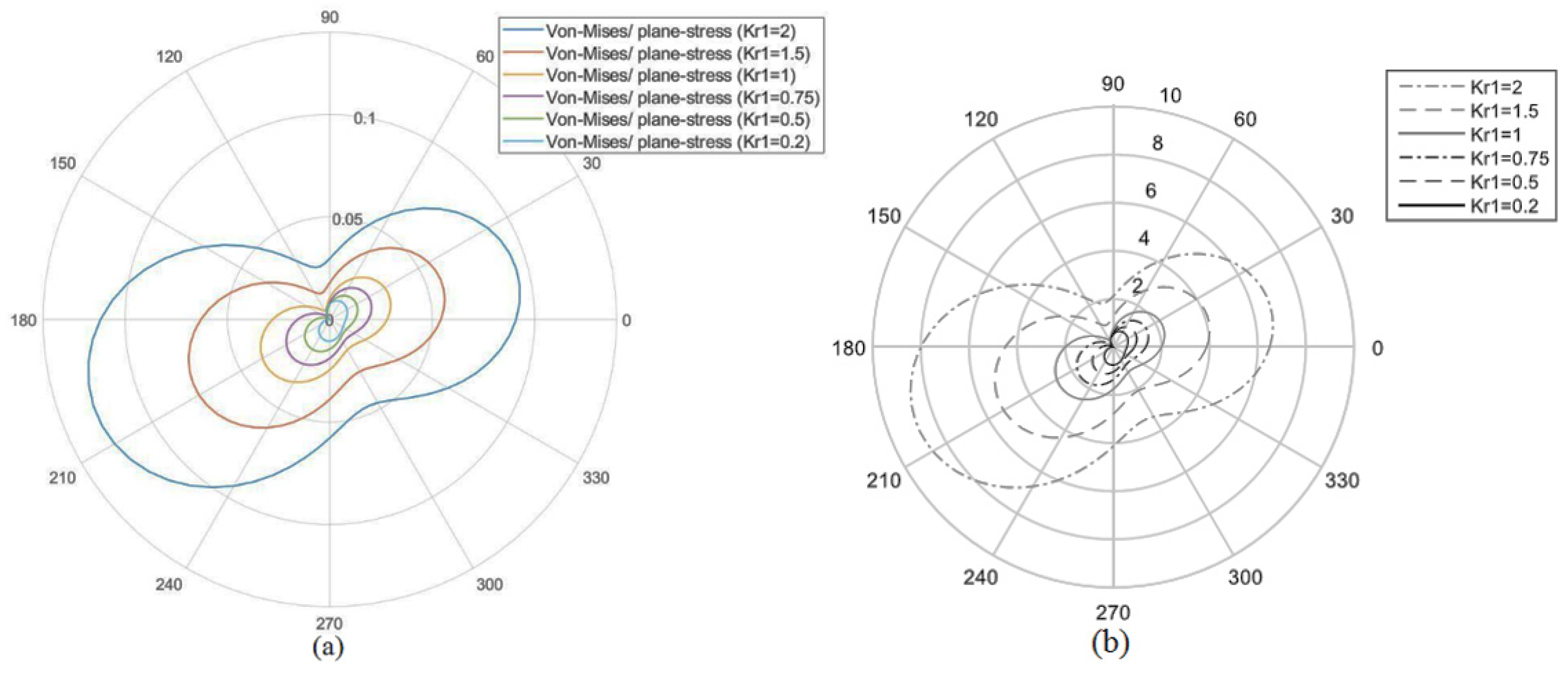
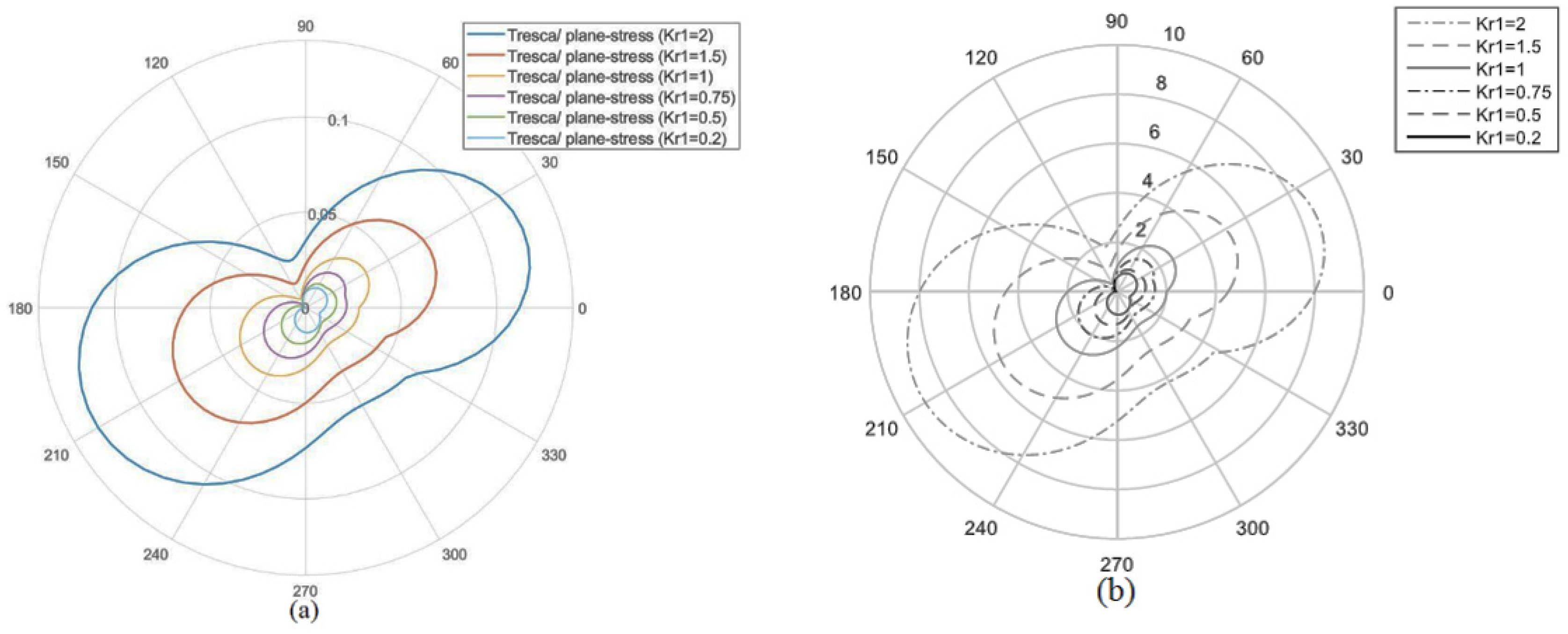
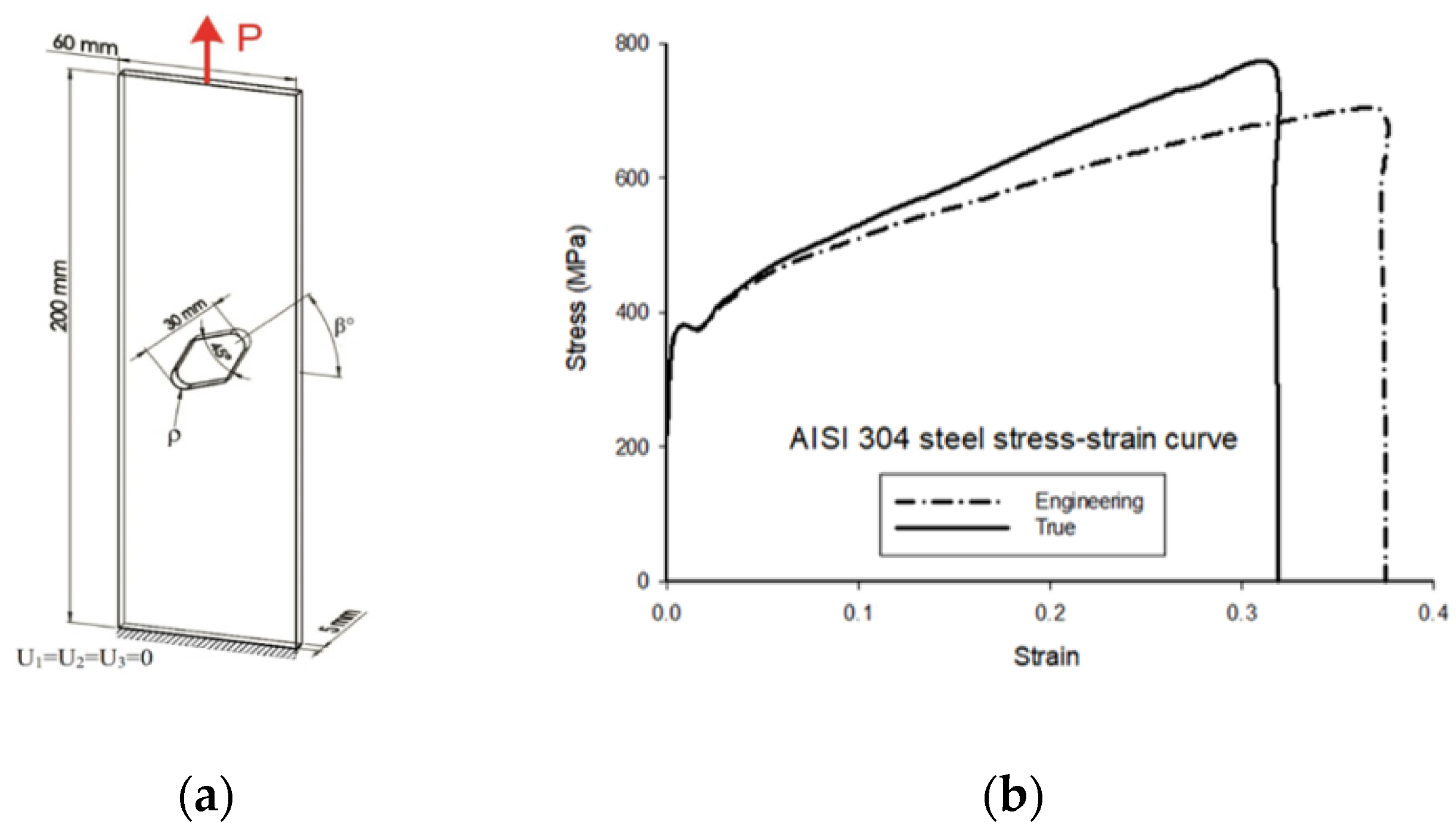
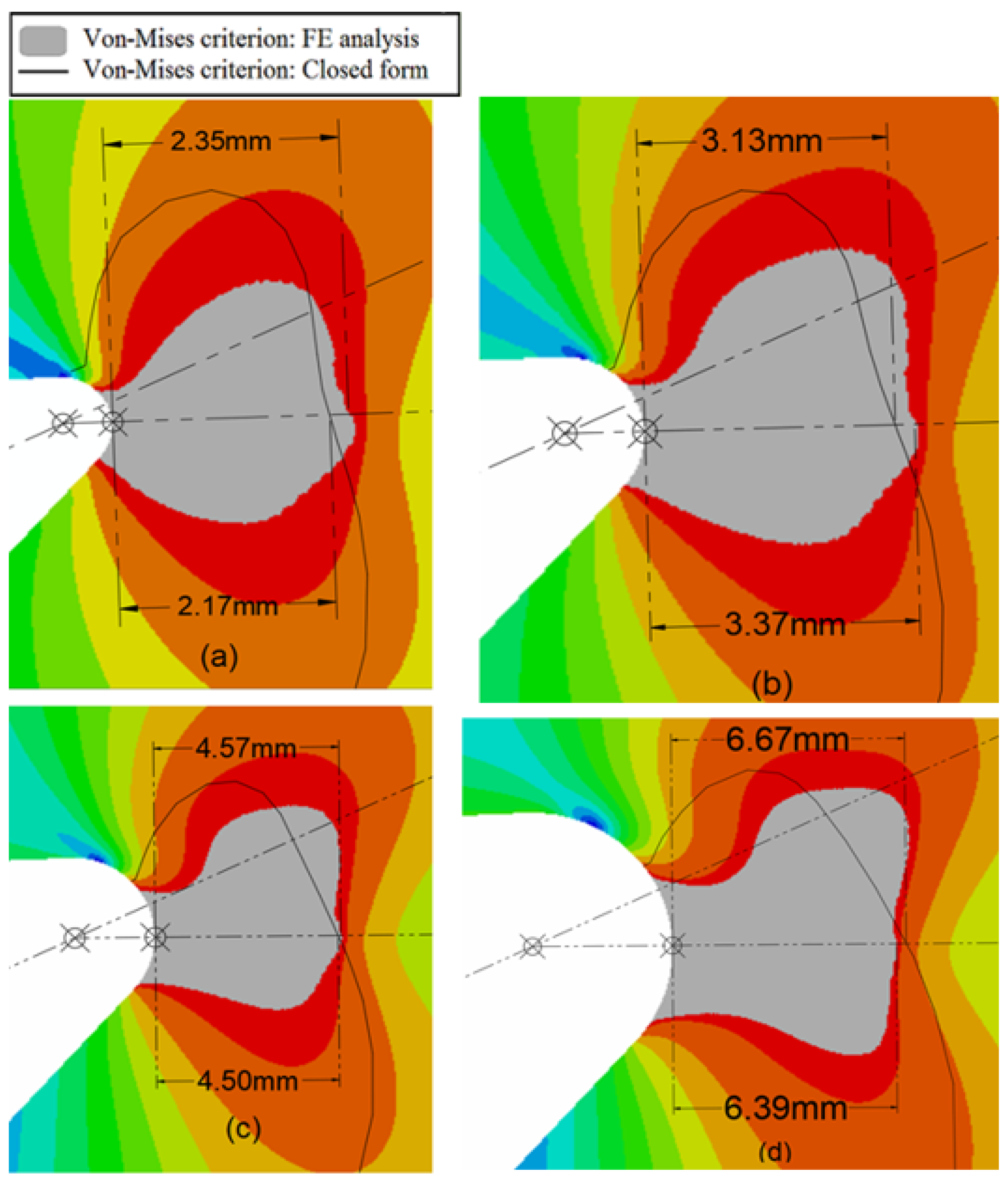




| ρ (mm) | von Mises | Tresca |
|---|---|---|
| β = 25° | β = 25° | |
| 0.5 | 7.7 | −7.8 |
| 1.0 | 7.1 | −7.0 |
| 2.0 | 1.5 | −12.5 |
| 4.0 | −4.3 | −17.1 |
| β = 50° | β = 50° | |
| 0.5 | 3.3 | 14.7 |
| 1.0 | −10.6 | 8.8 |
| 2.0 | −19.2 | −1.6 |
| 4.0 | −27.4 | −8.1 |
Publisher’s Note: MDPI stays neutral with regard to jurisdictional claims in published maps and institutional affiliations. |
© 2021 by the authors. Licensee MDPI, Basel, Switzerland. This article is an open access article distributed under the terms and conditions of the Creative Commons Attribution (CC BY) license (https://creativecommons.org/licenses/by/4.0/).
Share and Cite
Torabi, A.R.; Shahbazian, B.; Mirsayar, M.; Cicero, S. A Methodology to Determine the Effective Plastic Zone Size Around Blunt V-Notches under Mixed Mode I/II Loading and Plane-Stress Conditions. Metals 2021, 11, 1042. https://doi.org/10.3390/met11071042
Torabi AR, Shahbazian B, Mirsayar M, Cicero S. A Methodology to Determine the Effective Plastic Zone Size Around Blunt V-Notches under Mixed Mode I/II Loading and Plane-Stress Conditions. Metals. 2021; 11(7):1042. https://doi.org/10.3390/met11071042
Chicago/Turabian StyleTorabi, Ali Reza, Behnam Shahbazian, Mirmilad Mirsayar, and Sergio Cicero. 2021. "A Methodology to Determine the Effective Plastic Zone Size Around Blunt V-Notches under Mixed Mode I/II Loading and Plane-Stress Conditions" Metals 11, no. 7: 1042. https://doi.org/10.3390/met11071042






